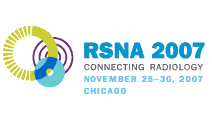
Abstract Archives of the RSNA, 2007
SSM19-01
Short-time Scale and Long-time Scale Regional Hyperpolarized 3He Diffusion MRI to Detect the Abnormalities in Smokers: Which Is More Sensitive?
Scientific Papers
Presented on November 28, 2007
Presented as part of SSM19: Physics (MRI and MRIS—Novel Methods)
Chengbo Wang PhD, Presenter: Nothing to Disclose
Talissa A. Altes MD, Abstract Co-Author: Nothing to Disclose
Grady Wilson Miller PhD, Abstract Co-Author: Research support, Siemens AG
Eduard Ellis de Lange MD, Abstract Co-Author: Nothing to Disclose
Kai Ruppert PhD, Abstract Co-Author: Nothing to Disclose
Jaime F. Mata PhD, Abstract Co-Author: Nothing to Disclose
John P. Mugler PhD, Abstract Co-Author: Research grant, Siemens AG
Research Consultant, Siemens AG
et al, Abstract Co-Author: Nothing to Disclose
et al, Abstract Co-Author: Nothing to Disclose
To compare the sensitivity of short-time-scale (STS; diffusion time ~ 1 ms) and long-time-scale (LTS; diffusion time ~ 1 s) hyperpolarized 3He (H3He) diffusion MRI to detect the abnormalities in the lungs of smokers.
A new MRI technique that collects co-registered STS and LTS H3He ADC maps in one breath hold was developed, and it was validated by measuring the diffusion of H3He in a 15X15X8 cm Tedlar bag. This “double-diffusion" sequence was performed in 20 healthy subjects: 15 healthy subjects who never smoked (5 males, 10 females, age: 44-66 yrs), and 5 active smokers (3 males, 2 females, age: 48-71 yrs, FEV1%pred: 58%-92%). In all subjects, co-registered multi-slice ADC maps were collected at two different diffusion times after inhalation of 400-700 ml of H3He diluted to about 1 litter with N2, and a 1.5T scanner (Sonata, Siemens) was used.
Measurements in the phantom yielded uniform ADC maps and mean ADC values consistent with the free diffusion coefficient of dilute 3He in N2 (~0.8 cm2/s). High-quality, co-registered ADC maps were obtained at the two different diffusion times in all subjects and the mean ADC values for healthy non-smokers match well with the literature values: 0.235 cm2/s for STS and 0.0192 cm2/s for LTS. The mean STS ADC values in smokers (mean±std: 0.322±0.057 cm2/s) were 37% greater than that for the healthy group (mean±std: 0.235±0.023 cm2/s), p<0.03; However, the LTS mean ADC values in smokers (mean±std: 0.0359±0.0079 cm2/s) were 87% greater than that for the healthy group (mean±std: 0.0192±0.0028 cm2/s), p<0.01. The change of LTS diffusion is significantly greater than that of the STS diffusion from non-smokers to smokers.
These findings suggest that LTS H3He diffusion MRI is more sensitive to detect the abnormalities of the lungs in smokers than STS H3He diffusion MRI. And the increase in both STS and LTS ADC values may represent the early/sub-clinical emphysematous changes due to the structural damage from smoking in the lungs.
Long-time-scale hyperpolarized 3He diffusion MRI is more sensitive to detect the abnormalities in smokers than short-time-scale hyperpolarized 3He diffusion MRI.
Wang, C,
Altes, T,
Miller, G,
de Lange, E,
Ruppert, K,
Mata, J,
Mugler, J,
et al, ,
et al, ,
Short-time Scale and Long-time Scale Regional Hyperpolarized 3He Diffusion MRI to Detect the Abnormalities in Smokers: Which Is More Sensitive?. Radiological Society of North America 2007 Scientific Assembly and Annual Meeting, November 25 - November 30, 2007 ,Chicago IL.
http://archive.rsna.org/2007/5006949.html

